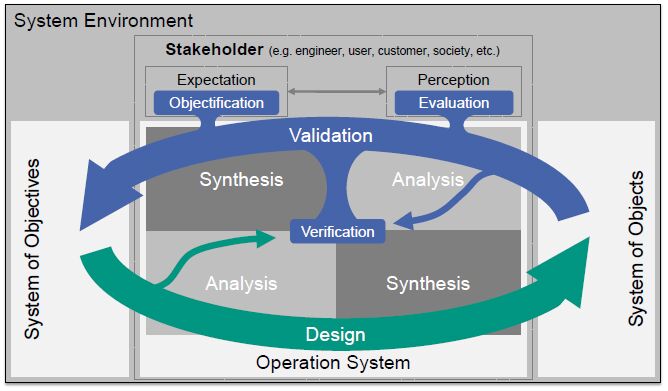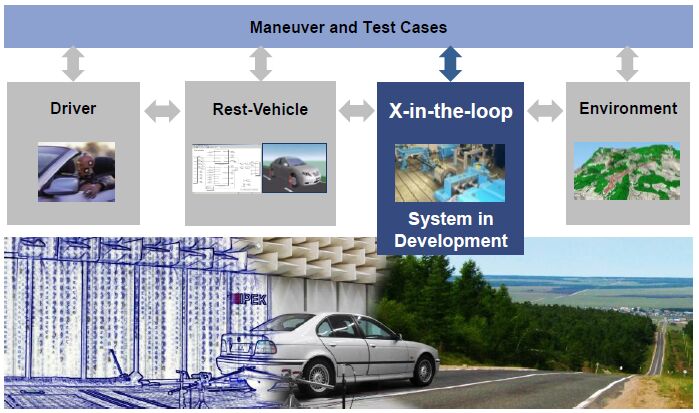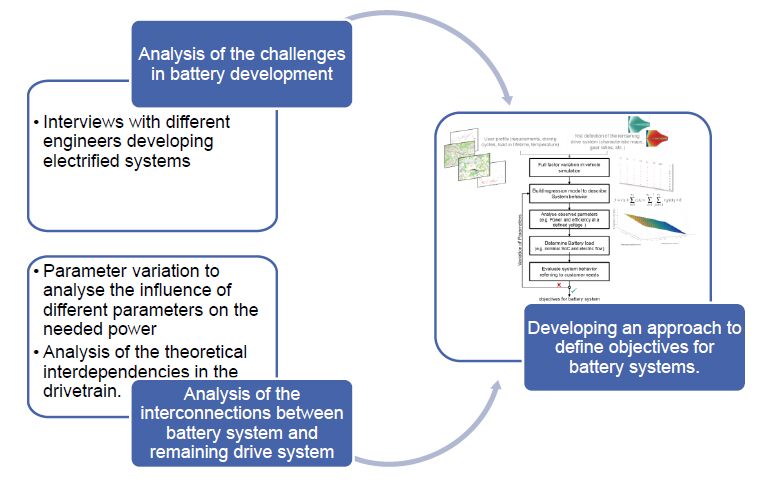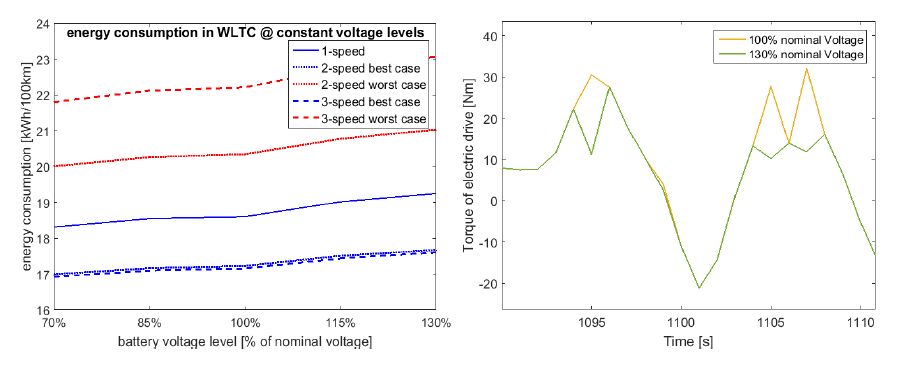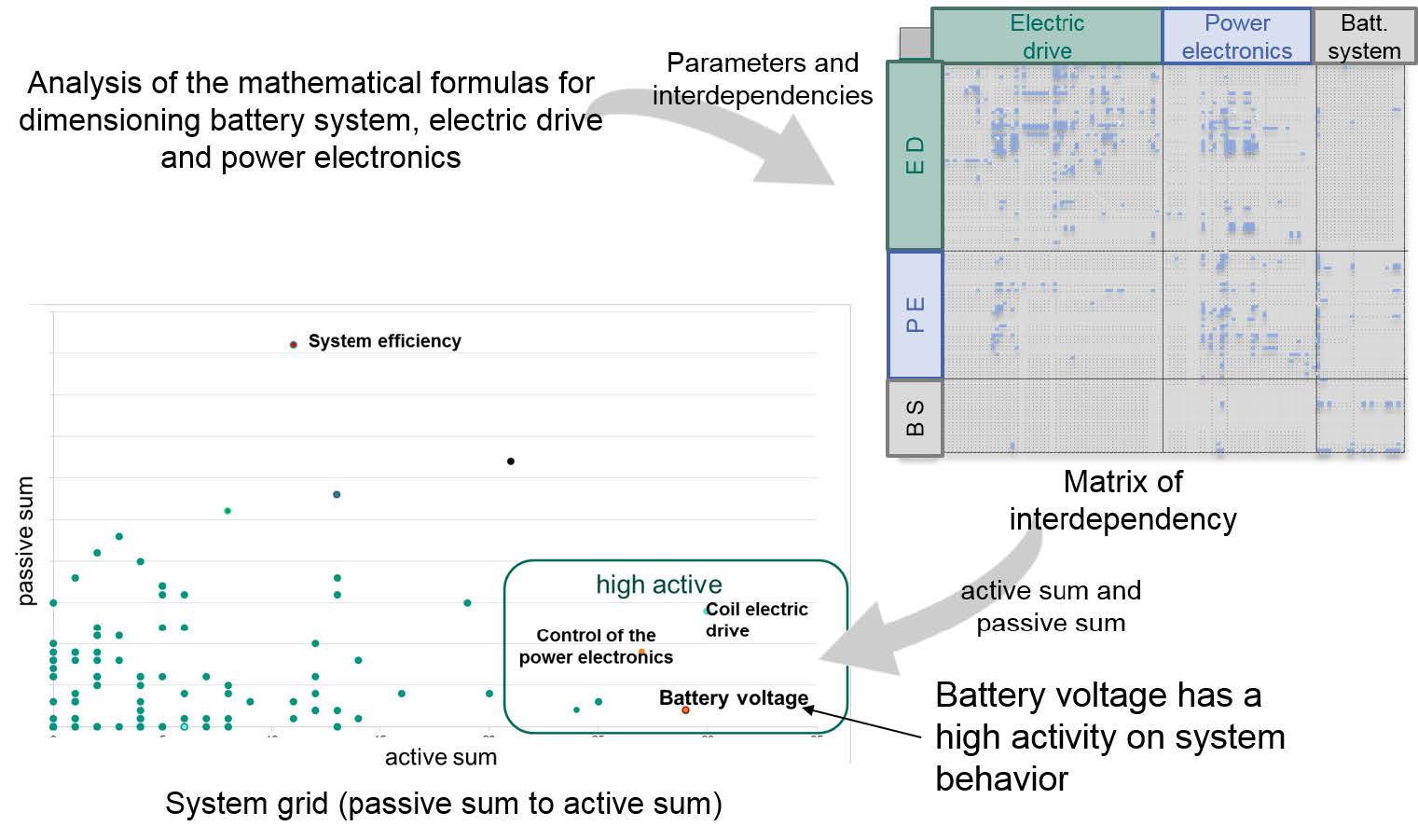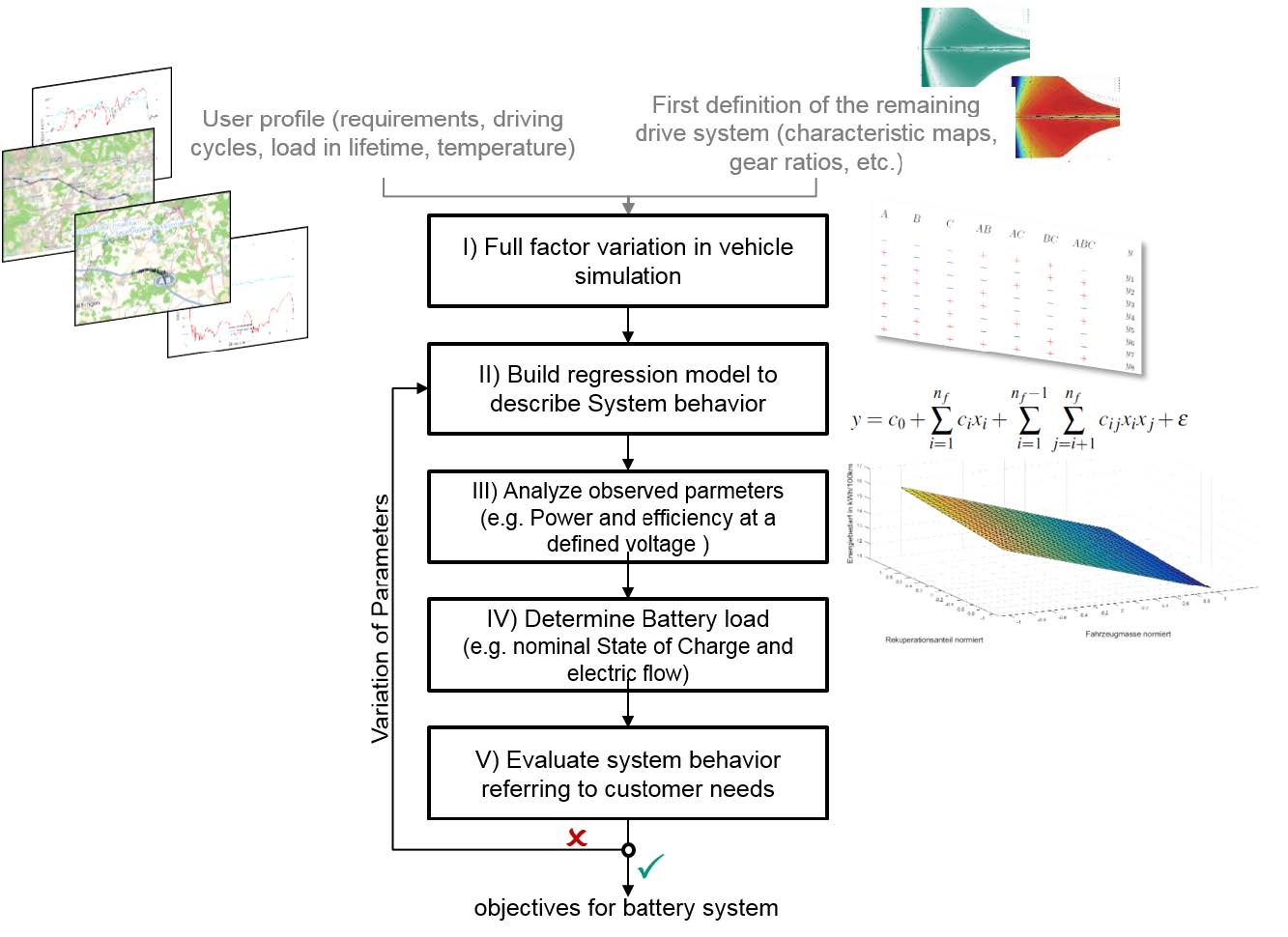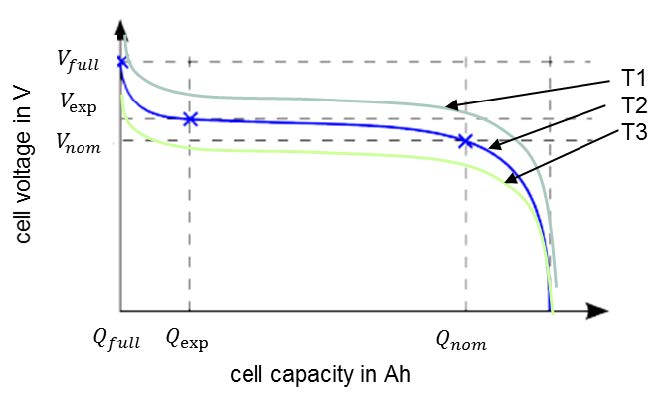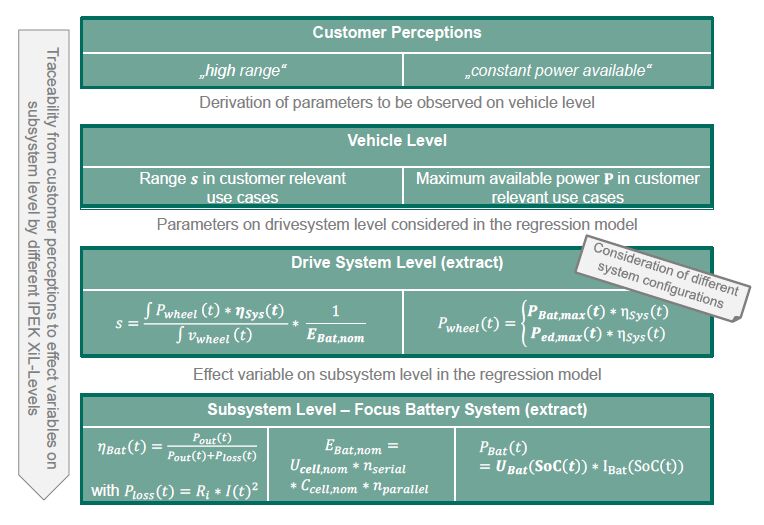1. Introduction
Many different circumstances lead to the increasing importance of electrified drive systems to passenger vehicles in private and public use. The first reason is the global shift of energies demanded by politics. Several laws and guidelines for example require decreasing emissions of carbon dioxide and lower energy consumptions of vehicle fleets. To support compliance with these requirements, large research funds are invested in the development of improved drive train and battery technologies. In addition, incentives for buyers of electric cars are being discussed. Secondly, there is a shift of environmental awareness in society. People mind their behavior and influence on the environment and try to act in a sustainable way. Thirdly, there is the increased driving pleasure offered by electric vehicles. Due to the high torque available from a standing position and the agile behavior of electric drives, high acceleration and sportive driving are possible.
But still, many reservations against electric vehicles exist. Two of the most named reservations in customer surveys are the costs and the vehicle range. In addition, the long time for charging and the safety of the cars are other often named concerns of the customers [1]. This leads to increased numbers of electric vehicles in serial production, in combination with increasing, but still low sales figures. The battery system is a main driver of the above reservations against electrical vehicles, because it influences aspects like vehicle range, charging time, costs [2]. Consequently, many research activities focus on the improvement of battery cells, e.g., increasing energy density, and on analyzing aging processes. These improvements play a major role in making electric mobility sufficient. But fulfillment of customer requirements also depends on the behavior of the whole drive system and, hence, on the behavior of the battery system within the drive system.
For the development of valid and economically efficient electric vehicles, it is not sufficient to focus on battery cells only. Modified cell behavior results in modified behavior of the battery system, the impact of this modified behavior has to be evaluated by considering the drive systems performance. Hence, a holistic view at the drive system and the objectives and requirements to be met by the battery system within the drive system is needed. In contrast to actual research on battery cells this work presents a novel and systematic approach to defining objectives and requirements for the battery system down to the behavior of battery cells by considering the drive system in relevant use cases. Significant is the understanding of the battery system as part of the whole drive system and therefore the importance of the interdependencies of battery system and remaining drive system in usage of the electric vehicle.
2. State of research
Chapter 1introduces the need of a holistic view at the battery system and its objectives to be met. Hence, the following chapter considers current research into battery systems, introduces a holistic view of the system to be developed or investigated by the IPEK X-in-the-Loop approach (IPEK-XiL), and explains the importance of objectives in product development.
2.1. Research into battery systems for electric drive systems
Often, the insufficient energy and power density of battery cells is named as a major problem of traction batteries because of the limited range of the vehicle and the long charging time. Consequently, most of current battery research focuses on battery cells. Development of new battery materials of higher energy and power density is one aim of future battery development. This is reflected, for example, by public funding of materials research [3]. Representation of existing battery systems in simulation models is another focus of current research. The models are used in different contexts. Behr et al., for example, introduce an approach to model-based calibration of a battery system [4]. Other battery models are used for simulations or physical tests of electrified drive systems on a test bench, for example by Kroeze et al.[5]. Together with the feasibility of battery systems, also thermal aspects and mechanisms of aging are examined. Herb e.g., analyzes aging [6], Tan et al. and Wieland et al.study thermal aspects of battery cells [7,8].
In addition to these investigations, research concentrates on development processes for battery systems and their complex interdependencies. Schaeper identified principal interdependencies inside a battery system, e.g., electrical and mechanical [9]. Rothgang explains that battery pack design has to deal with the balance of different aspects, such as power, weight, volume, and costs. The solution space within available battery cells is shown and it is pointed out that battery pack design is not only interconnecting the cells, but also e.g. dimensioning the cooling [2]. Bouvy et al.also underline that battery pack design is associated with multiple interactions and resulting conflicts. He introduces a holistic, integrated, and simulation-based process for developing battery packs and emphasizes the importance of considering the application and the available cells [10]. Janiaud et al. analyze the influence of the battery voltage level on the efficiency of the drive train to optimize the battery in the context of the vehicle performance [11].Albers et al.also demonstrate interconnections of battery system with the properties of the surrounding drive system [12].
2.2. Objectives in product engineering
Defining objectives for battery systems and battery cells in context of the electric vehicles’usage means to deal with manifold interactivities. Physical interactivities of subsystems in the drive system have to be considered as well as interactivities of the subsystems’requirements. Gained knowledge within the product development process of an electric vehicle (for example about the efficiency of the planed electric drive) leads to concretization of the drive system and the battery system. Accompanying this concretization, the properties of the current drive system and battery system have to be matched with the actual objectives for the systems’behavior. This leads to new findings and to concretization of the objectives to the battery system. Especially in development of electric vehicles many new findings and many recursions are expected within the product development process because of the low experience with electric vehicles in series production. For an easier handling of this complex process the product development process can be described by a general model as follows.
The process of product engineering can be described by a system theory approach as transferring a system of objectives into a system of objects by an operation system. The system of objectives contains all anticipated and planned attributes of the system of objects [13]. In addition to the objectives, it also contains the boundary conditions and the interdependencies of the objectives. Hence, different classes of objectives are included, with the requirements of the product being only one of them. Within the product engineering process, the system of objectives is constantly expanded and concretized by generating new information [14]. The operation system is a sociotechnical system and includes designers as well as activities, methods, subprocesses, and resources for realization. The system of objects contains all items and documents corresponding to the system of objectives [15].
The transfer from the system of objectives to the system of objects and constant concretization are characterized by sequences of analysis and synthesis (Figure 1).
Based on the knowledge of the operation system, the system of objectives is synthesized. Analysis of the system of objectives leads to more information about the solution space that is transferred to the system of objects. By analyzing the documents and items within the system of objects, the state of knowledge increases and the system of objectives can be concretized. This leads to the finding that objectives play a major role in product development. Systemic interdependencies lead to huge connectivity and dynamics. Simultaneously, the objectives are affected by the uncertainty of partial information [16]. Often, the uncertainty can be handled by knowledge based on previous development and product generations. Large stocks of carryover and experience gained from shape variation and principle variation allow for gaining experience and improving the state of knowledge of the operation system [17]. A huge challenge in product engineering processes of electric vehicles for serial production is lacking experience caused by the low number of previous development and product generations.
Figure 2 shows the iterative transfer of a system of objectives into a system of objects in context with validation and design. According to Albers, validation is a central activity of product development. It ensures the market success of a product [18]. Validation enables the gain of information and knowledge to concretize the system of objectives in a continuous way. By concretization, the objectives can become more detailed or can be revised.
Validation mainly consists of three steps: verification, evaluation and objectification. Verification means checking the conformity of system of objects’elements and system of objectives’elements. Evaluation means analyzing the system of objects’elements from the stakeholders’point of view. Stakeholder are defined as people interested in the results of product development, e.g., engineers, users, customers, society. Objectification contains checking the current representation of customers’perceptions in the system of objectives as well as identifying potentials to increase the system of objectives’objectivity. The more the system of objectives’elements are described in an objective way, the easier is the verification of system of objects in context to system of objectives. Hence, main aspect of objectification is investigating interconnections between quantitative parameters (criteria for analysis) and perceptions (criteria of evaluation) from the stakeholders’point of view [19].
2.3. IPEK X-in-the-Loop approach (IPEK-XiL)
The investigations in chapter 2.1 suggest a holistic view at electric drive systems is expedient to developing valid battery systems. Further, chapter 2.2 shows the importance of quantitative objectives considering stakeholder and system environment. Hence, IPEK-XiL now is introduced to explain the basic understanding of subsystems’validation by considering the interconnections with surrounding systems.
Figure 3 shows the IPEK-XiL. Its central aspect is the holistic view of the system to be developed or investigated (“X”). The system“X”is always seen in context of the interacting systems. In case of“X”being subsystem of a vehicle, the interacting systems are rest-vehicle, driver, environment, and maneuver and test cases. All of these systems can be represented either physically, virtually or in a mixed physical-virtual way. Depending on the aim of the validation, the“X”can be a system in development (SiD) or, if gaining knowledge about the system behavior is in the focus, a system under investigation (SuI). The system can exist on different system levels from functional contacts up to the whole vehicle. Hence, the IPEK-XiL offers a framework for a holistic view on systems in development and systems under investigation.
2.4. Interim conclusion for the state of research
Continuous expansion and concretization of the system of objectives is a central aspect in product engineering processes to develop successful products for the market. Success of products depends on valid objectives and therefore on quantitative representation of stakeholder’s perceptions in context of the system’s environment. Although an adequate system of objectives is of high importance to successful products and the development of battery systems taking into account many interconnections, there are no systematic approaches to deriving and concretizing objectives for the battery system and cells in current research. To improve the properties of future battery systems in electric vehicles a systematic approach to defining objectives to be met by the battery system in context of the surrounding systems is needed. The IPEK-XiL-approach provides a holistic view of the system in development with regard to the interacting systems, hence, it provides a basis for a systematic approach to defining objectives.
3. Research focus and methodology
3.1. Research focus
Considering the current state of research, there is a high potential of developing sufficient battery systems for electric vehicles by transferring stakeholders’perceptions into concrete and quantitative objectives for the battery system. This leads to the need of finding an adequate approach to supporting the identification of objectives for battery systems based on stakeholders’point of view.
3.2. Steps of research
The development of an approach to identifying objectives for battery systems is based on some previous steps. They aim at analyzing major challenges and interdependencies in battery development (Figure 4).
The first step is identifying main challenges in battery development by analyzing several interviews with engineers that develop electrified applications. In this way, an overview is to be obtained of the difficulties and the lacks of support in the development of battery systems for electrified applications. The second step is doing a simulation-based parameter variation of an electric drive system in connection with the system’s driver and environment. Here main influences are identified on system behavior and battery load. In a third step the theoretical interdependencies within the system’s electric drive, power electronics, and battery system are analyzed to identify the main system parameters that influence system behavior. Based on the findings of these steps, requirements are derived for an approach to identifying objectives for battery systems. These requirements lead to a proposal of an approach.
4. Complexity of developing battery systems
Chapter 2pointed out that battery development is more complex than interconnecting battery cells in series or in parallel. Consequently, the complexity of developing battery systems is analyzed in three steps (see chapter 3.2).
4.1. Challenges in battery development
In a previous project, semi-structured interviews of engineers in battery development were made [20]. Initially, the interviews focused on finding relevant technical factors influencing the development of battery systems. Systematically, a large pool of questions was created. Based on this pool, two different questionnaires were derived, one for engineers in battery cell development, one for engineers in the development of electrified applications. With help of these questionnaires, personal interviews were made to gather technical requirements and factors influencing the battery system, such as electrical, mechanical, thermal, legal, and information technology factors [20].
Although the interviews had a clear technical focus, also opinions relating to the challenges in battery development can be extracted from seven of the interviews with engineers in application development. They can be summarized as follows:
● The properties of the battery system and the battery cells restrict the functionality of the application on different levels. Electrically speaking, applications are limited by possible operation points. For example, the current limit blocks the desired function. There are also thermal and mechanical restrictions. For example, the lifetime of the cells depends on the thermal operation area, which is why adequate cooling is required, but cooling itself needs additional energy and space.
● Cells are selected specifically for every type of application, because the electrical and mechanical cell properties determine the behavior of the system. Therefore, the interdependency between battery system and use case has to be considered.
● Available cells and their properties are boundary conditions for the development of the system. Development of specific cell properties normally is not carried out or accomplished under certain conditions only.
These opinions of the challenges in battery development are confirmed by literature. Schaeper and Rothgang, for example, show the interdependency of cell properties and thermal and mechanical properties of the battery system. They also point out that the available cells are boundary conditions [2,9]. Rothgang additionally emphasizes the importance of the use case and the required functionality to the battery design.Bouvy et al.explain the multiple interdependencies within the battery pack design and also mention the selection of one out of the battery cells available as a boundary condition [10].
4.2. Parameter variation
To analyze the influences of the use case, the driver, and the remaining drive system on the battery load, a parameter variation with a efficiency-based backward simulation is done. Because the main function of the battery system within the drive system is delivering power, the purpose of the simulation model is representing the needed power, energy and current in the battery system at different drive system configurations. Figure 5shows the structure of the simulation model.
The simulation only considers longitudinal acceleration, because it has the main influence on the required power. For this purpose, the traction needed at the wheels is calculated. Needed vehicle parameters are the vehicle mass, the wheel diameter, the friction coefficient, and the front surface. Also a driving cycle as velocity-time course is given. Multi-speed-gearboxes are also potential solutions for electric vehicles [21], therefore a multi-speed functionality is as well considered in the simulation model as a single-speed functionality. The gearbox is presented by the transmission steps (i) and an assumed overall efficiency (eta). The efficiency of the gearbox is assumed between 85% (worst case) and 98% (best case). In detail gearbox-efficiency depends on multiple parameters, e.g., load and speed that can be simulated with some time effort [22], but to analyze the influence of different efficiencies on the battery load it is sufficient to assume them as constant for one gearbox-concept over the whole driving cycle. Based on these parameters, the needed torque and speed at the wheels can be transformed into the needed torque and speed of the electric drive. To examine the influence of the shifting strategy, gear shift is determined by the best system efficiency in every time step (best case) and the worst system efficiency in every time step (worst case). The electric drive and the power electronics are represented by efficiency maps for different voltage-levels. The efficiency maps are results of detailed simulations or physical examinations of the electric drive and the power electronics and represent the power loss in every operation point characterized by torque and speed of the electric drive. With the interpolated efficiency at the current operation point, the power needed by the battery system can be calculated. To analyze the principle influence of the parameters on the battery load, the battery voltage is assumed to be a constant value within one driving cycle. The simulation results offer a comparison of battery load in the driving cycle between different voltage-levels. In the context of the battery voltage, the current-time plot can be calculated. The energy content of the battery system can be determined for a required vehicle range. Considering a defined cell capacity and voltage, also the course of the c-rate can be estimated as a measure of cell load.
IPEK-XiL provides a holistic view of the interconnections of driver, drive system, environment, and maneuver. Using the IPEK-XiL, the variation parameters are defined. System under Investigation (SuI) is the battery system, it interacts with the surrounding systems.
Figure 6 shows the variation parameters defined in IPEK-XiL. Considering the maneuver and test case, the varied parameters are vehicle velocity, the driving route, and the additional load. To investigate the influence of the driver, different driver profiles are taken into account. In the remaining vehicle the vehicle mass is a varied parameter as well as the properties of the electric drive and the efficiency, number of gears, and transmission in the gearbox. Also the shifting strategy is varied from best case (best system efficiency) to worst case (worst system efficiency). Additionally, the proportion of recuperated energy is varied. The environment is considered by different traffic situations, e.g., stop-and-go or floating traffic.
Velocity, driving route, traffic flow, and driver profiles are represented in the simulation model by different driving cycles based on measured real-world-data with different drivers and vehicles [23]. For this purpose, measured driving data of different routes and drivers were analyzed. On thisbasis, velocity-time courses were selected, which represent different routes driven by different driver profiles under the same traffic situations.
The findings of parameter variation are summarized as follows:
● Within one vehicle class (represented by the vehicle mass) and voltage level, the maneuver, the velocity, and the traffic situation have the main influence on the battery load.
● Next to the maneuvers, the properties of the gearbox and the electric drive define the load on the battery system but in comparison their influence is much lower than the influence of the maneuvers. Different voltage levels lead as well to different battery loads as to different drive system performance based on two effects. First the battery current needed for the actual required power changes at different voltage levels. Second with multi-speed gearboxes the operation points of the drive system differ at the same situation in the driving cycle at different voltage levels and therefore to different power losses and energy consumptions (Figure 7). This effect is caused by the different efficiency-behaviors of the electric drive and the power electronics. Some operation points arenxt possible so a different gear step is chosen.
● In case of multi-speed-gearboxes also the shift strategy influences the energy consumption. Figure 7 shows, that a suboptimal shift strategy is worse in comparison to a good chosen single speed than the benefit of an optimal shift strategy.
4.3. Analysis of interconnections in the electric drive system
To study the interdependencies within the electric drive system, a third analysis is made. The mathematical formulas for describing and developing the electric drive, the power electronics, and the battery system are analyzed. Based on a detailed literature search, main system parameters for fulfilling the system’s function are identified. Figure 8 shows the process of analyzing the interdependencies.
Based on the mathematical formulas, the system parameters and their interdependencies are compiled. For example, the function of battery system can be described by the voltage, the capacity and the internal resistance of the battery cell. Power electronics can among others be described by the input voltage and the control method. Describing parameters for the electric drive are for example the number of coils, ,current and voltage in the coils. The parameters are clustered for the three systems and written down in a matrix of interdependencies. This leads to a matrix, consisting of nine sub-matrices, three for the interconnections within every system itself and two sub-matrices that describe the interconnection with the two other systems for every system. For every interconnection between two parameters, the matrix is filled with“1”. Meaning of this“1”is parameter in row is influenced by parameter in column. Based on this, the rows and columns of every parameter are summed up. This leads to two figures for every factor, which indicate the influence of the parameter on the other parameters by sum up the columns (active sum) and the influence of the other parameters on the parameter by sum up the rows (passive sum). Both figures can be entered in a system grid to graphically identify different parameters. With regard to the battery system, the battery voltage has a main active influence on the other systems [24]. This corresponds, for example, to the investigations of Janiaud et al., who analyzed the influence of battery voltage on the system efficiency by a simulation model [11].
4.4. Interim conclusion
Development of a battery system means dealing with interdependencies on different levels.Inside the battery system, aspects like cell behavior, electrical and mechanical interconnections have to be considered as well as thermal control and safety of the cells. On a superordinate system level, the battery is interconnected with the surrounding drive system. Objectives and requirements of the drive system and vehicle cause requirements on the battery system and vice versa. Objectives and requirements met by the drive system are connected to the perceptions of the stakeholders, especially of the customers. Hence, the battery behavior plays a major role for the system’s functionality. In this connection, the use case, the properties of the remaining subsystems in the drive system, and the battery voltage are main aspects that should be considered.
5. Simulation-based approach to defining objectives for battery systems
Based on the state of research and the findings regarding the complexity of developing battery systems, requirements to be met by the approach are derived. Considering these requirements, an approach to defining objectives for battery systems is introduced.
5.1. Requirements to be met by the approach
To find a suitable approach to deriving objectives for battery systems, the requirements to be met by the approach itself are identified to easily derive objectives for battery systems based on the objectives on the vehicle level. Chapter 2 shows the importance of transferring customer perceptions into quantitative objectives by validation to enable developing successful products. Special challenge of electrified drive systems is lacking of experience caused by the low number of previous development and product generations. Hence, the approach should support evaluation of battery and drive system properties in context of the customer perceptions.
Considering the results of chapter 4, there are three main aspects the approach should include. The interviews confirm that the battery system leads to functional limits of the application. Hence, the approach should consider different users and use cases to evaluate the system’s performance. The parameter variation revealed that apart from the use cases, the properties of the remaining drive system influence the requirements of the battery system. This leads to the need of a suitable representation of these subsystems by the approach. The analysis of the mathematical interactions between the subsystems of the drive train identified the battery voltage to be a major factor influencing system behavior. For this reason, different voltage behaviors of the battery cells should be presented. For this representation, a suitable model of the battery cells is necessary. The requirements to consider different use cases and the properties of the remaining drive system result in the need for modeling the whole system of driver, drive system, and environment. As regards the easy derivation of objectives for the battery system, the model has to allow for an easy change of system parameters without high calculation effort.
5.2. Approach
Figure 9 shows the approach to deriving objectives for battery systems presented in this paper. Different boundary conditions are considered. The user profile is assumed to be known. Typical driving cycles and the behavior of the driver are available. In addition, a first definition of the remaining drive system is available. There are characteristic maps of the electric drive and the power electronics. The number of gears and the gear ratios are assumed to be defined and an efficiency value is calculated roughly. Based on this information, a simulation model is built in MATLAB®/Simulink® similar to the model described in chapter 4.2. In addition to the model in chapter 4.2, the battery is modeled to provide different battery behaviors.
The aim is to transfer customer perceptions on electric vehicles into quantitative objectives to be met by the battery system. For this purpose, a simplified model of the drive train is sufficient, which represents the electric drive and power electronics by efficiency maps and the gearbox by a combination of efficiency value, number of gears, and gear ratios. The vehicle itself is represented by the vehicle mass, diameter of the wheels, and the resulting traction force for longitudinal speed and acceleration within a driving cycle. System behavior for different use cases and different battery configurations is taken into account.
In step I this simulation model is used for a full factor variation of significant parameters as basis for describing the behavior of the whole drive system regarding different system configurations, e.g., cell behaviors, number of gears, characteristics of electric drives etc. This enables reflection of different battery properties in context of drive train behavior and customer perception. The challenge is to define sufficient variation factors and limits for the later evaluation of the system behavior. Based on the results of this variation in step II, a regression model is built to easily describe the drive systems’behavior with different combinations of subsystems’parameters. This model allows for analyzing observed parameters, such as energy efficiency and available power, for the chosen combinations of parameters in step III. Step IV addresses the resulting battery load, e.g., nominal SoC and occurring c-rate. Based on the results of steps three and four, the evaluation of the whole system behavior with regard to customer needs follows in step V. If the system behavior is evaluated as satisfying, the battery parameters can be defined as objectives for the battery. Otherwise, the regression model provides an easy way to evaluate system behavior with different combination of parameters.
As central aspects within the introduced approach, the battery model for full factor variation in vehicle simulation in step I, the building of the regression model in step II, and the evaluation of system behavior in step V will be explained in more detail below.
6. Battery model for full factor variation in vehicle simulation in step I
For full factor variation, the vehicle simulation model in chapter 4.2 is complemented by a battery model. Basically, there are several options to simulate battery behavior. As written in chapter 2.1, most of them aim at presenting the behavior of existing battery cells in the vehicle, e.g., for application of the battery management system or simulation on a test bench. These use cases require a simulation model to be as exact as possible. In the presented use case, objectives for the battery system and for the behavior of battery cells are to be compiled. This leads to the following two requirements on the battery model: 1) No need for measurement of battery cells to parameterize the simulation model, 2) ability to change the simulated battery cell behavior in small steps in order to estimate the whole system behavior with different cell properties. Here, an analytic battery model was chosen, because it could be parameterized by the discharging voltage curve of the battery cell and because it allows for a change of the battery cell behavior by changing the discharging voltage curve.
Vogel built a model library in MATLAB®/Simulink® for simulating different batteries at a vehicle test bench [25]. These models are based on a discharging model presented by Tremblay and Dessaint[26], complemented by a submodel to calculate the actual state of charge (SoC), a submodel to consider capacity fade by different currents, and a submodel to consider the influence of the temperature [25]. The advantage of this analytic model is the parameterization by nine points of voltage and remaining capacity: Three characteristic points of every discharging curve and three discharging curves for different temperatures (Figure 10). In addition to these points, also the inner resistance of the cells Ri, the corresponding current for the discharging curve Iconst, and the constant of Peukert k are needed.
Knowing the information needed to parameterize the simulation model, these points can be used to vary the assumed properties of the battery cells. Variation parameters are
● the gradient of the discharging curve represented by the ratios of the three V/Q points,
● the distance between the discharging curves of different temperatures (T1, T2, T3), and
● the inner resistance of the cells.
Combined with the variation parameters of the remaining drive system given in chapter 4.2, a full factor variation of the whole system is possible.
7. Building the regression model in step II
Regression models are used to present the interactions between parameters of a system and, hence, the system behavior. Usually, regression models are built to represent interactions of measured data, but it can also be used for simulated data. Advantage of regression models is the fast and easy way to estimate system behavior considering different observed system properties at different system configurations. Observed properties for example could be the vehicle range or the available power at different state of charges. System configurations are different combinations of the variation parameters according to step I). Hence, the regression model enables comparing different system configuration with regard to customer’s perceptions.
In a first try, a linear regression model is used. For this purpose, the variation parameters are assumed to be independent for reasons of simplification. In further research also the dependency of the parameters will be considered to find out whether another regression model is more helpful for identifying objectives to be met by the battery system.
8. Evaluation of the system behavior in step V
The chapters above emphasize the importance of concrete and quantitative objectives for developing successful products. The transparent derivation of these objectives for single subsystems in context of the system behavior on vehicle level is challenging.
Unlike the simulation model the regression model allows for evaluate customer perceptions with regard to different configurations of the drive system’s subsystems without iterative calculations. Hence, estimating the system behavior and analyzing the influence and interconnection of different subsystems is possible. Defining concrete objectives can be done by scrutinizing the impact of objectives not be met.
Based on these facts, concrete objectives for the behavior of battery system and battery cells in an electric vehicle can be defined with regard to the customers perceptions. Figure 11 demonstrates the process by a simplified example. Customer perceptions are a high range of the electric vehicle without limitation of available power (e.g., because of decreasing SoC). These perceptions can be transferred in technical requirements on single subsystems like the battery system by consideration of the interconnections between different system levels. Therefore system level gets more detailed step by step to enable traceability.
Customer perceptions are vague statements, they are neither quantitative nor objective. Nevertheless parameters on vehicle level can be observed to indicate the fulfillment of customer perceptions. The perception“high range”is for example indicated by the range“s”in customer relevant use cases, “constant power available is indicated by the maximum available power in different use cases. These indicators are represented in the regression model and therefore are connected to the physical interdependencies on different levels. On the level“drive system”for example the range depends on the required power at wheel, the system’s efficiency and the energy content of the battery system. The available power at the wheel depends on the limiting subsystem at the current operation point, this could for example be the electric drive’s available power or the available power of the battery system regarding the current battery voltage. Further it depends on the system’s efficiency. On this IPEK-XiL level, the regression model allows for consideration of different system configurations within the varied parameters in the full factor simulation. Hence, the systems behavior can be evaluated in a holistic way. To defining concrete objectives for the battery system and for battery cells, the level of detail has to be increased to subsystem level. On this level, the effect variables for the battery system and for battery cells can be identified, in these examples they are the inner resistance, the number and interconnection of cells, and the voltage curve depending on the state of charge.
Hence, the regression model enables evaluating system behavior on vehicle level in context of different system configurations on drive system and subsystem level. Based on the evaluation concrete figures for the objectives can be defined. The holistic view makes traceability possible from customer perceptions to quantitative objectives.
9. Conclusion
Objectives and their interconnection and boundary conditions in terms of a system of objectives are pointed out to be a central aspect in developing successful products. One challenge is the transparent transfer of customer perceptions into quantitative objectives for the subsystems. Especially the development of battery systems in electrified drive systems has to deal with a high complexity and interconnectivity, combined with lacking experience caused by low numbers of previous product generations. Finding sufficient objectives and identifying their reasons and interdependencies, hence, are essential for the development of customer-oriented future battery systems.
Interviews, simulations, and analysis of the mathematical formulas confirm the manifold interconnections between drive system and battery system to be a central challenge in battery development. In research relating to the development of battery systems, the complexity of interactions is known in principle, but often underrated. Cell properties usually are assumed to be boundary conditions for the development of battery systems. Due to the interconnections, however, there is a huge potential in also considering the remaining drive system in cell development. The potential as well as the challenges of the complex interdependencies must not be neglected when developing battery systems. In particular, the system of objectives must reflect the multiple interdependencies. Approaches and methods are needed to support the definition of objectives and their complex interactions and reasons in a systematic and transparent way. This paper proposes an approach based on parameter variation to deriving objectives for battery systems and battery cells taking into account the interacting systems and the usage of the vehicle.
Conflict of interests
All authors declare no conflicts of interest in this paper.









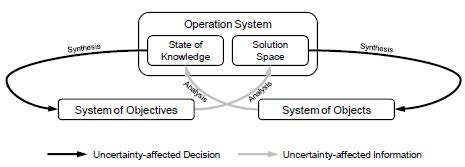
 DownLoad:
DownLoad: 